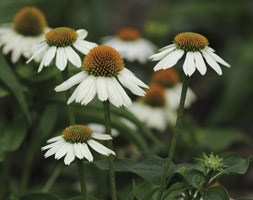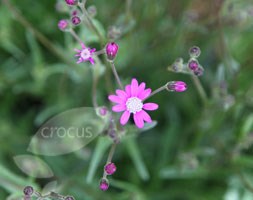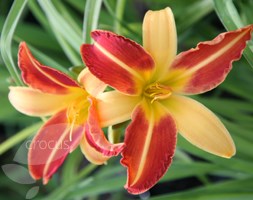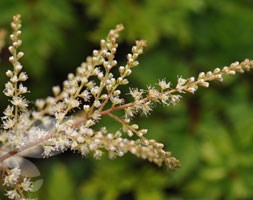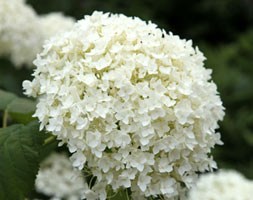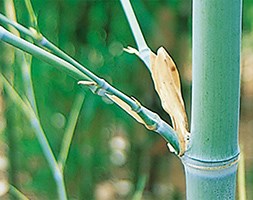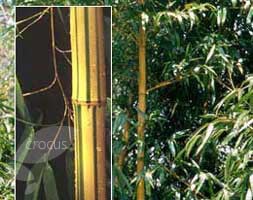Price reductions at Crocus
by Sarah - May 25th, 2014.Filed under: Crocus, Price Reductions.
Crocus has cut the price of these products
Echinacea PowWow White (‘Pas709018’) (PowWow Series) (coneflower) was £4.99 now £2.49
Position: full sun Soil: most soils, except very dry or boggy Rate of growth: average Flowering period: June to September Hardiness: fully hardy Compact and full of summer flowers, this coneflower is a great value option for both perennial borders and prairie-style planting schemes. Like all coneflowers, the flowers will act as a magnet for bees and butterflies and later on birds will find the seedheads tempting. Garden care: Lift and divide congested colonies in autumn or spring. In autumn cut back all dead flower stems to the ground. Coneflower s benefit from a spring or autumn mulch with well-rotted compost.
Senecio polyodon (senecio) was £4.99 now £4.49
Position: full sun Soil: tolerates most well-drained soils Rate of growth: average Flowering period: May to September Flower colour: pink, purple, magenta or violet Hardiness: fully hardy A native of South Africa where it is found growing in sunny grassland, this deciduous plant does best in a sunny spot with well drained soils, where it will form a vigorous, long-flowering carpet of colour throughout summer. Forming a basal rosette of leaves, it sends up sprays of daisy-like pink, magenta, violet or pink coloured flowers with yellow centres from late spring to autumn. When happily settled, it may self-seed and produce new plants. Garden care: Try to avoid excessive winter wet and dead-head if you dont want it to spread.
Hemerocallis ‘Frans Hals’ (daylily) was £5.99 now £4.99
Position: full sun Soil: fertile, moist, well-drained soil Rate of growth: average Flowering period: July Hardiness: fully hardy An unusual daylily, with masses of rust-red and orange bi-coloured flowers appea ring continuously in midsummer. Each flower has three dusty-orange outer petals and three bronze inner petals with a prominent yellow midrib. This plant looks fabulous planted in drifts in a sunny mixed or herbaceous border among ‘hot’ colours, or with cannas and montbretias as companions. The bright green, strap -like leaves are evergreen in mild areas, and soon form large clumps of strap-li ke foliage that helps to suppress weeds. Like most hemerocallis, it is robust and easy to grow, provided you follow the tips below. Garden care: The Greek term ‘hemerocallis’ means ‘beautiful for a day’, and daylilies need regular deadheading to prolong flowering and prevent their unsightly deadheads from dominating the scene. Each stem carries several flowers, so snap off each flower as it fades. When the stem has finished flow ering, cut it down to the ground. After the plant has finished flowering altoge ther, pull out the dead leaves. When the foliage is looking tatty, cut it down to the ground and fresh new growth will appear. Lift and divide every three years in spring to keep the rhizomes vigorous and apply a generous 5-7cm (2-3in) mulch of well-rotted garden compost or manure around the base of the plant. Water frequently from spring until the buds appear.
Aruncus aethusifolius (goatsbeard) was £7.99 now £6.49
Position: full sun or partial shade Soil: moist, fertile soil Rate of growth: average Flowering period: June and July Flower colour: creamy-white Hardiness: fully hardy Branching plumes of tiny, creamy-white flowers appear in June and July above the deeply cut, green foliage. Emerging in spring with a bronze flush the foliage will turn buttery yellow in autumn before it dies back. This is a slowly spreading perennial, which will gradually form dense clumps, so it makes a very effective groundcover for moist, shady beds. For the best results chose a spot that remains reliably moist over summer. Garden care: Cut back the flowered stems back hard to just above ground-level in autumn and apply a generous mulch of well-rotted garden compost or manure around the base of the plant.
Hydrangea arborescens ‘Annabelle’ (sevenbark) was £8.99 now £8.49
Position: full sun or partial shade Soil: moist, well-drained, moderately fertile, humus-rich soil Rate of growth: average Flowering period: July to September Hardiness: fully hardy One of the loveliest hydrangeas, this has huge globes of tightly packed, creamy white bracts that look like giant snowballs in late summer. As autumn progress es, the blowsy flowerheads fade to pale lime and the dark green, pointed leaves turn soft yellow. It has an upright habit and makes a breathtaking feature in a wide, partly shady border, particularly when planted in groups or with other hydrangeas. The flowerheads are a popular choice for dried flower arrangements . Contact with the foliage may aggrevate skin allergies. Garden care: Hydrangeas do not like to dry out. In dry weather, soak the roots with a hose and the plant will usually recover. Remove faded flowerh eads in spring after the danger of frosts, cutting back the flowered stems to a strong pair of buds. Take out misplaced or diseased shoots. Mulch young plant s with a well-rotted manure or compost in spring. Once established, remove a quarter to a third of the shoots to the base of the plant.
Phyllostachys glauca (bamboo) was £29.99 now £24.99
Position: full sun or partial shade Soil: humus-rich, moist, well-drained soil Rate of growth: average Leaves: dark green Canes: blue-green Hardiness: fully hardy A rare clump-forming, then spreading bamboo. The new canes are an attractive shade of greenish-blue and look like they have been dusted with white powder. Later they lose the blue flush and become greener as they canes mature. The leaves are glossy and dark green though glaucous underneath. A superb specimen plant, it looks great in a contemporary, minimalist garden or a town garden. To prevent the plant from colonising adjacent plantings restrict the roots using a rigid, non-perishable barrier. Garden care: Plant in a large container or surround the roots with a non-perishable barrier that restricts the plant’s spread. If potted up, it is important that this plant is watered regularly.
Phyllostachys vivax f. aureocaulis (phyllostachys bamboo) was £34.99 now £29.99
Position: full sun or partial shade Soil: humus-rich, moist, well-drained soil Rate of growth: fast growing Leaves: mid-green Canes: rich yellow Hardiness: fully hardy A spectacular large bamboo with rich yellow canes and mid-green leaves. The canes have unusual green markings giving the appearance that they have been randomly painted by a mischievous child. To guarantee success grow in a site protected from high winds, where the colourful canes can be seen throughout the year. Garden care: Plant in a large container or surround the roots with a non-perishable barrier that restricts the plant’s spread.
Phyllostachys glauca (bamboo) was £49.99 now £39.99
Position: full sun or partial shade Soil: humus-rich, moist, well-drained soil Rate of growth: average Leaves: dark green Canes: blue-green Hardiness: fully hardy A rare clump-forming, then spreading bamboo. The new canes are an attractive shade of greenish-blue and look like they have been dusted with white powder. Later they lose the blue flush and become greener as they canes mature. The leaves are glossy and dark green though glaucous underneath. A superb specimen plant, it looks great in a contemporary, minimalist garden or a town garden. To prevent the plant from colonising adjacent plantings restrict the roots using a rigid, non-perishable barrier. Garden care: Plant in a large container or surround the roots with a non-perishable barrier that restricts the plant’s spread. If potted up, it is important that this plant is watered regularly.







